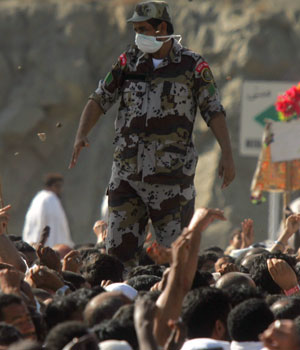
A Saudi police officer directs Muslim pilgrims throwing stones at a pillar representing the devil during the hajj, in Mena, Saudi Arabia, Jan. 10, 2006 (AP)
MENA, Saudi Arabia,(Reuters) – More than two million Muslim pilgrims pelted stones at symbols of the devil in the second day of a sacred ritual on Wednesday amid tight security to avert stampedes during the haj pilgrimage.
Pilgrims from all over the world gather in the holy city of Mecca each year for the five-day haj, which is a duty for every able-bodied Muslim at least once in a lifetime.
Haj, one of the most striking manifestations of religious faith in the world today, has often been marred by tragedy.
Some 250 pilgrims were crushed to death in 2004 at Mena’s Jamarat Bridge, on which the millions of pilgrims must stand while they hurl stones at three thick walls in a symbolic casting out of the devil and rejection of temptation.
Some pilgrims headed to the bridge early on Wednesday to avoid crowds later, when many prefer to follow to the letter Prophet Mohammad’s example of stoning after noon prayers.
“I was a little scared at the thought of crowds of people in a small space all wanting to stone quickly and leave, especially that my mother is with me,” said Morhaf al-Feen, 21, from Syria. “Thank God the first day passed easily and, God willing, this day will be good too.”
This year’s haj has been overshadowed by the collapse of a Mecca hostel that killed 76 people last week and warnings of a possible spread of deadly bird flu due to the huge crowds.
Two children in Turkey, from where many pilgrims come, are confirmed to have died from the H5N1 strain. Many pilgrims come from east Asia, where 76 people have died since 2003.
The deadly virus is hard for people to catch and is almost invariably transmitted by close ocntact with infected poultry.
Saudi Arabia has spent 25 million riyals ($6.7 million) on Tamiflu, a drug that can reduce the severity of the current bird flu strain if taken within days of symptoms appearing.
It has deployed 60,000 security men to control the huge crowd and avert attacks by Islamist militants.
Dozens of ambulances were spread throughout the Jamarat area and helicopters monitored pilgrim traffic, which flowed smoothly in the cool early hours.
“At first, I was scared of a stampede occurring during stoning or of the spread of bird flu but I took my precautions,” said Hamed Taha, 31, from Chad.
Pilgrims perform the stoning ritual three times between Tuesday and Thursday, when they make a final visit to the Grand Mosque in Mecca, according to rules laid out by Prophet Mohammad 1,400 years ago. It passed without incident on Tuesday.

A Muslim pilgrim gets his head shaved symbolising the completion of his Haj pilgrimage in Mena, 10 January, 2006 (EPA)

Muslims pilgrims throw stones at a pillar representing the devil in Mena, 10 January, 2006 (EPA)
